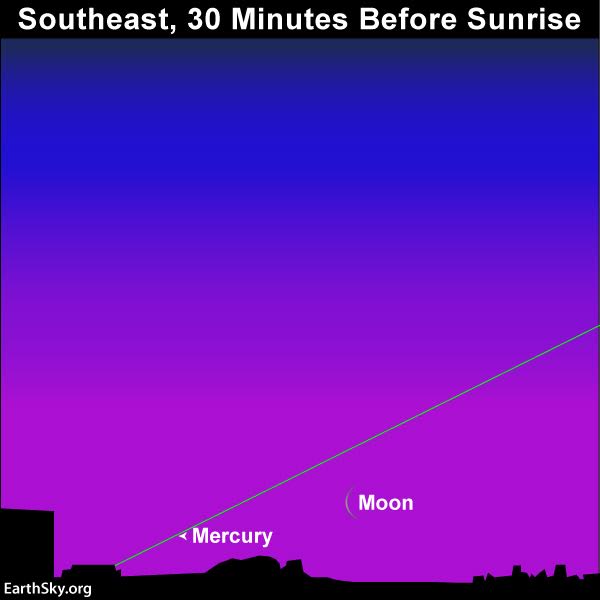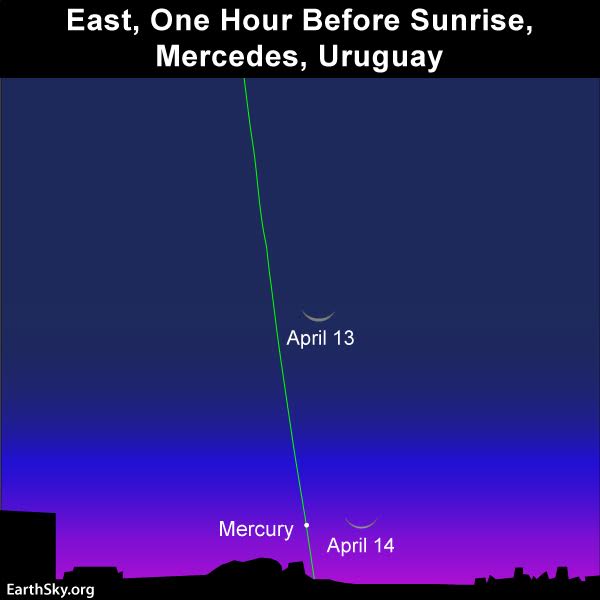For Southern Hemisphere, moon and Mercury before sunup April 13 and 14
We have good news for our friends in the Southern Hemisphere. The next two mornings – April 13 and 14, 2018 – offer a grand view from your part of the world of the waning crescent moon and planet Mercury before sunrise. Our featured chart at top is designed for about 33 degrees south latitude (Mercedes, Uruguay; Cape Town, South Africa; Sydney, Australia), but other southerly latitudes are comparable.
Meanwhile, from our northerly latitudes, the view will be much tougher to see. The angle of the moon’s path with respect to the Northern Hemisphere’s sunrise horizon will be much more shallow, placing both the moon and Mercury low in the sky. Those at mid-northern latitudes might catch the thin waning crescent moon – what’s sometimes called an old moon – on the morning of April 13. Mercury might or might not be visible, even with an optical aid. On April 14, the moon will be even harder to see – difficult, if not impossible – from mid-northern latitudes.

No matter where you live worldwide, it’ll be to your advantage to find an unobstructed horizon in the direction of sunrise. That’s especially true if you’re in the Northern Hemisphere. Binoculars are always a plus, and they’re likely necessary from the Northern Hemisphere. Mercury is only of second-magnitude brightness right now. By this month’s end, when Mercury reaches its greatest western (morning) elongation from the sun, it’ll be about four times brighter than it is at present.
On April 13 – from Mercedes, Uruguay, South America – the moon rises about two hours and 40 minutes before sunrise. Meanwhile, Mercury comes up nearly one hour and 30 minutes before the sun. One day later, on April 14, the moon rises about one hour later whereas Mercury comes up about five minutes sooner. At similar latitudes in the world’s Eastern Hemisphere (Cape Town, South Africa, and Sydney, Australia), Mercury rises at a similar time before sunrise, but the moon comes up somewhat sooner than it does in Mercedes, South America.
From middle latitudes in North America, the moon rises one hour (or less) before sunrise while Mercury climbs above the horizon about 40 minutes before sunup. From mid-northern latitudes in the Eastern Hemisphere – Europe and Asia – the moon rises somewhat sooner before the sun but Mercury comes up an hour or less before sunrise.
Click here for recommended sky almanacs; an almanac can give you the rising times of the moon and Mercury in your sky.
At mid-northern latitudes, Mercury sits in the glow of morning twilight throughout the months of April and May.
From temperate latitudes in the Southern Hemisphere, Mercury will rise sooner before the sun day by day. At Mercury’s greatest elongation from the sun on April 29, Mercury will come up more than 2 hours before the sun. In fact – from the Southern Hemisphere – Mercury will climb over the eastern horizon before dawn’s first light for approximately a month, from mid-April to mid-May 2018. This apparition of Mercury in the morning sky will be the year’s best for the Southern Hemisphere.
Bottom line: Live in the Southern Hemisphere? Look for the moon and Mercury to adorn the morning sky before sunrise on April 13 and 14, 2018. Meanwhile, from the Northern Hemisphere, this same view of the moon and Mercury is tougher to see.












